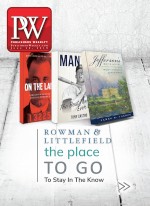How do you foster a child’s love of reading? Vikki VanSickle, associate director of marketing and publicity for the young readers program at Penguin Random House Canada, has some ideas. Raising readers, VanSickle says, starts with creating a home- grown library collection.
To that end, Toronto-based children’s publisher Tundra Books, part of the Penguin Random House family, has launched the Tundra Tots campaign, as part of a broader platform called Building Your Baby’s Library. The board books and preschool picture books in this collection were carefully selected to spark early inter- est in reading, while providing developmentally appropriate content that aligns with cognitive, physical, and emotional growth stages in early childhood.
VanSickle, who is also a children’s and YA author, notes that books focused on developmental milestones have a tendency to be pedantic. Also, parents who are aware of such milestones may experience anxiety around their child’s development. “Meeting so- called milestones can start to feel a bit clinical or create tension if a parent believes their child is behind,” VanSickle says. But early reading ought to be, first and foremost, fun and engaging.
The titles in this curated collection focus on specific skill sets while inspiring creativity and inviting imaginative thinking. “We wanted to address these stages,”
VanSickle says, “but also give parents a new way to think about book selection by emphasizing delight, passion, and the personal connection between reader and listener.”
The books in the campaign fall into six thematic categories. High Contrast books are designed with a baby’s eyesight and visual perception in mind. These titles use contrasting colors like black and white, which infants register most strongly and which assist in the development of the optic nerve. An example of a title in this category is Can You Find My Robot’s Arm?.
Rhyming Text books, such as If I Had a Gryphon by VanSickle herself, promote pattern and word recognition, while their rhythmic text calms babies when read aloud. Books in the Simple Concepts category, such as Counting with Barefoot Critters and A Northern Alphabet, introduce counting, the alphabet, and opposites. Bedtime Books, such as Solutions for Cold Feet, are soothing titles made for winding down. Interactive Text titles such as Sometimes We Think You Are a Monkey encourage reader participation through interactive features like sound effects and prompts that invite active reading.
Finally, the Classic Characters books contribute to early literacy while appealing to parents through figures they may recognize from their own childhoods. By witnessing their parents enjoying the reading experience, young readers are more likely to also embrace books. “If you are a diehard Anne Shirley fan, reading to your child from Kelly Hill’s Anne’s Feelings—a concept book inspired by L.M. Montgomery’s Anne of Green Gables— is going to be more fun for you and will therefore resonate with your child more than it would if you were reading a concept book that did not feature a character that you love,” VanSickle says.
While the Classic Characters line aims to connect with parents’ nostalgia for familiar characters, VanSickle says the entire Tundra Tots collection is a line of “modern classics that move beyond standard baby shower fare into books that feature contemporary attitudes, modern approaches to ever- green concepts, fresh art, and stories and characters that both parent and child can enjoy.” Beloved classics like Goodnight Moon will always be favorites, but VanSickle believes that there is room for much more. She hopes that the Building Your Baby’s Library pro- gram will inspire parents to expand their ideas about first books and what they might look like—specifically, books that communicate directly with young children and their immediate experiences.
The line has launched with 15 “core titles” across the six categories and will add several books each year. The titles may be purchased individually, providing opportunities for readers to seek out and select each one—also a vital component of becoming a self-guided reader. “Becoming an autonomous reader, however, begins with parents embracing a habit of reading with their kids every day,” VanSickle says.
While the board book market remains competitive, VanSickle is confident that the curated collection, and the guiding philosophy that having a personal home library matters, will be embraced by parents.
The collection’s central conceit may seem intuitive, but it requires the advocacy of parents and other gatekeepers. Literacy is beneficial for kids not only in terms of laying the seeds for sight reading but also in helping to build confidence, a sense of curiosity, and emotional well-being. “Children are not responsible for many of the decisions in their lives,” VanSickle says. “Someone else tells them when to get up, what to eat, where to go. Choosing a book is an act of power and an assertion of identity.” The key to fostering a love of reading? “Having a whole collection of books that belong to them,” she says. “It helps children to articulate who they are and what they like and ultimately creates lifelong positive associations with books and reading.”



 Volume 266
Issue 23
06/10/2019
Volume 266
Issue 23
06/10/2019





